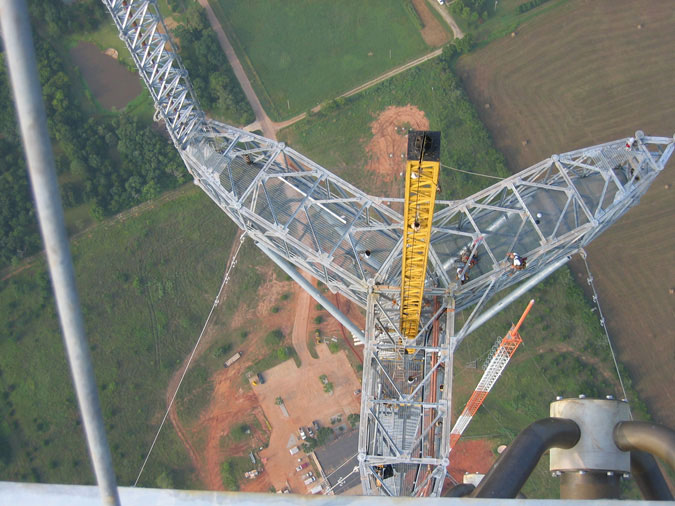Answer the guys questions - not a load of gobbledegook.
- FM: 64-108 MHz, 87-108 MHz, 87.5-108 MHz (tuning step 10kHz or 100kHz)
- MW (AM): 520-1710 kHz, 522-1620 kHz (tuning step 1kHz, 9kHz, or 10kHz)
- LW: 100-519 kHz (tuning step 1kHz or 9kHz)
- SW: 1711-29999 kHz (tuning step 1kHz or 5kHz)
VHF FM (frequency modulation) is a broadcast band and for you in the US it will be from 87.5 to 108 MHz - In most area the stations are allocated frequencies that are 100kHz apart so that they don't interfere with one another.
LW - long wave - one of the remains of early radio broadcasting, they found that with sufficient power and huge antennas you could send over huge distances with morse code (on-off keying of the transmitter) and later they found how to modulate the carrier with voice. Hugely expensive and now fading out all over the world. You may hear a couple of Europeans but extremely rare - more likely an aircraft beacon with a couple of morse characters for identification.
MW - medium wave, broadcast band, AM (amplitude modulation) - call it what you like, it's all the same. For many years the only short distance broadcast band available for local areas. Very crowded in the 30's onwards and prone to whistles and interference until the FM band took over in the 50's - now mainly just chat shows and sports. Can travel over a long distance at night - many people have great fun with special antennas to receive long distance signals.
SW - shortwave - many frequencies with many uses. I have attached my chart to show you how the frequencies are divided up. The broadcast bands will have stations from all over the world BUT you have to be aware of the time of day at your end and their end and the frequency in use. Roughly you can say that the middle of the day is probably the worst time to try receiving anything and on the high frequency bands. Favourite times to receive on the lower frequency bands is late afternoon through the night until dawn - but the transmitter has to be in darkness too. In your late afternoon you should hear stations from your east and in the early mornings from your west. My charts give you all the broadcast bands and what is often called "utility" stations. The utility stations on the aeronautical frequencies don't really have bands, just designated frequencies and they don't talk all the time - so it's best to find a frequency and sit on it. All aero frequencies are USB - upper sideband - but more of this later. Amateur bands you may notice are all sub-multiples except for some new bands - this was so that amateurs ("hams") could use simple home-made transmitters which were fixed at a single frequency and used the harmonics to cove the other bands. Methods of sending information on the ham bands range from simple morse code through amplitude modulation for voice and SSB - LSB below 9MHz and USB above - this was because when SSB was first developed for hams there was a ready supply of 9MHz filters and this produced LSB below and USB above. Marine broadcasting is more or less defunct now with the adoption of "GMDSS" in lieu of a radio operator on every ship along with all the apparatus - see here...
https://gmdss.com - all almost all ship communications are done via satellites.
AM, FM, SSB, LSB, USB - all forms of transmitting information. The basic transmitter produces a "carrier" which it itself carries no information at all, it's when you "modulate" the carrier that the information is attached to it. The simplest form of modulation is to turn the carrier on and off in accordance with the "morse code" - every alphabetical character, number, punctuation and accented letter has be assigned a specific sequence of 'dots' and 'dashes' which can be made with a hand 'key' and resolved at the receiver by another operator and written down. It's main advantage is that the equipment can be very simple, the signal takes up very little space in spectrum, and it gets though interference very well.
Amplitude modulation is simply that - the carrier has the audio signal mixed with it which changes the amplitude and at the receiver the audio is recovered in a detector which strips out the carrier and leaves the audio for you to listen to. Frequency modulation does exactly that - the frequency of the carrier is changed up and down by the amplitude of the audio signal. A special 'discriminator" in the receiver detects the frequency variations and changes them into amplitude variations so we have received our audio information.
Now SSB gets complicated but I'll try to keep it simple. If you look at an AM signal from a time perspective, you can see the changes in amplitude but if you look at it from a frequency perspective you can see the carrier remains at a constant level but flanking the carrier are two "sidebands". The sidebands which contain the audio frequencies are added or subtracted from the carrier. Now because the carrier contains no information and the sidebands are identical but opposite we can eliminate the carrier and one sideband and still transmit the signal. at the receiver a new carrier is re-inserted to beat with the sideband and reproduce the original audio - the higher frequency sideband of course is called the upper sideband, USB, and the lower, LSB.
There are many other forms of modulation but far too complicated at this stage.
Hope you have wriggled your way through all this but you will get the hang of it the more you play with your radio - have fun!.



